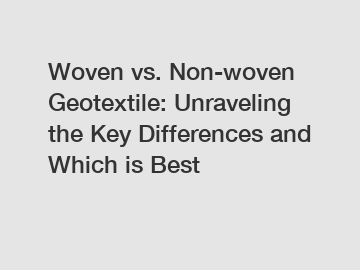Dec. 19, 2023
Construction
Geotextiles play a crucial role in our modern society, particularly in civil engineering and construction projects. These specialized fabrics are designed to enhance the performance, strength, and durability of soil foundations by acting as a barrier or reinforcement. When it comes to geotextiles, two popular options emerge - woven and non-woven geotextiles. In this blog, we will delve into the essential dissimilarities between these geotextile variations and help you understand which option may suit your project best.
Understanding Woven Geotextiles:
Woven geotextiles are created by interlacing durable polypropylene or polyester yarns in a crisscross pattern. This weaving technique gives them a high degree of strength, stability, and tear resistance. Woven geotextiles are commonly recognized for their robust nature, making them ideal for applications that require a high load-bearing capacity. These geotextiles are designed to provide reinforcement and stabilization, preventing soil erosion while improving overall soil integrity. Their regular porosity facilitates water flow, making them an excellent option for drainage purposes as well.

Exploring Non-woven Geotextiles:
Non-woven geotextiles, on the other hand, are manufactured by bonding fibers together using a combination of heat, mechanical, and chemical techniques. These fabrics are made of polyester or polypropylene fibers, offering excellent dimensional stability and filtration properties. Unlike woven geotextiles, non-woven variants have a random arrangement of fibers, imparting them with greater flexibility and permeability. Due to their unique manufacturing process, non-woven geotextiles exhibit characteristics such as exceptional filtration and soil separation, making them an ideal choice for drainage, filtration, and separation applications.
Key Differences:
1. Strength and Load Bearing Capacity:
Woven geotextiles, with their interlaced yarn structure, demonstrate higher tensile strength and load-bearing capacity compared to non-woven geotextiles. If your project requires substantial reinforcement or stabilization, such as road construction or retaining walls, woven geotextiles are the better choice.
2. Filtration and Drainage:
When it comes to filtration and drainage applications, non-woven geotextiles excel. The random arrangement of fibers in non-woven fabrics promotes efficient water flow while preventing soil erosion. They are commonly used in applications like French drains, filtration behind retaining walls, and underlayments for artificial turf installations.
3. Cost Considerations:
Further reading:In terms of cost, non-woven geotextiles are generally more affordable than their woven counterparts. However, it is important to note that woven geotextiles offer higher durability and longevity, which can often offset the initial price difference in the long run.
Which is Best for Your Project?
Selecting the ideal geotextile largely depends on the specific requirements of your project. Consider the following factors:
1. Project Type:
For heavy-duty projects that involve significant stress or load-bearing requirements, woven geotextiles are the optimal choice. These projects may include roadways, embankments, or stabilization of soils with poor characteristics.
2. Drainage or Filtration Projects:
Non-woven geotextiles are the go-to option for projects where filtration, separation, or drainage is a priority. These projects typically involve applications such as drainage systems, erosion control, and retaining wall backfill.
3. Longevity and Durability:
If your project demands a longer lifespan and higher durability, woven geotextiles offer a greater advantage. These fabrics are designed to withstand heavy loads, abrasion, and environmental factors for extended periods.
Conclusion:
It is essential to thoroughly assess your project requirements before determining the appropriate geotextile variant. Woven and non-woven geotextiles each possess unique qualities that cater to diverse engineering needs. Consulting with industry experts and geosynthetic engineers can provide further guidance in making an informed decision. Remember, investing in the right geotextile is crucial for ensuring the long-term success and stability of your project.
Are you interested in learning more about geocell supplier, geomembrane for water conservancy project, geo grid mesh? Contact us today to secure an expert consultation!
Further reading:Related Articles
If you are interested in sending in a Guest Blogger Submission,welcome to write for us!
All Comments ( 0 )